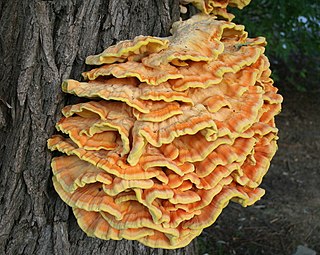
Laetiporus is a genus of edible mushrooms found throughout much of the world. Some species, especially Laetiporus sulphureus, are commonly known as sulphur shelf, chicken of the woods, the chicken mushroom, or the chicken fungus because it is often described as tasting like and having a texture similar to that of chicken meat.

Polypores are a group of fungi that form large fruiting bodies with pores or tubes on the underside. They are a morphological group of basidiomycetes-like gilled mushrooms and hydnoid fungi, and not all polypores are closely related to each other. Polypores are also called bracket fungi or shelf fungi, and they characteristically produce woody, shelf- or bracket-shaped or occasionally circular fruiting bodies that are called conks.

Laetiporus sulphureus is a species of bracket fungus found in Europe and North America. Its common names are crab-of-the-woods, sulphur polypore, sulphur shelf, and chicken-of-the-woods. Its fruit bodies grow as striking golden-yellow shelf-like structures on tree trunks and branches. Old fruitbodies fade to pale beige or pale grey. The undersurface of the fruit body is made up of tubelike pores rather than gills.

Cerrena unicolor, commonly known as the mossy maze polypore, is a species of poroid fungus in the genus Cerrena. This saprobic fungus causes white rot.

Meripilus giganteus is a polypore fungus in the family Meripilaceae. It causes a white rot in various types of broadleaved trees, particularly beech (Fagus), but also Abies, Picea, Pinus, Quercus and Ulmus species. This bracket fungus, commonly known as the giant polypore or black-staining polypore, is often found in large clumps at the base of trees, although fruiting bodies are sometimes found some distance away from the trunk, parasitizing the roots. M. giganteus has a circumboreal distribution in the northern Hemisphere, and is widely distributed in Europe. In the field, it is recognizable by the large, multi-capped fruiting body, as well as its pore surface that quickly darkens black when bruised or injured.
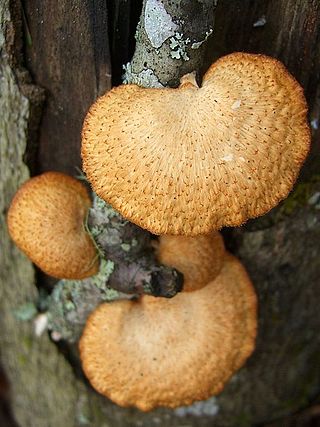
Neofavolus alveolaris, commonly known as the hexagonal-pored polypore, is a species of fungus in the family Polyporaceae. It causes a white rot of dead hardwoods. Found on sticks and decaying logs, its distinguishing features are its yellowish to orange scaly cap, and the hexagonal or diamond-shaped pores. It is widely distributed in North America, and also found in Asia, Australia, and Europe.
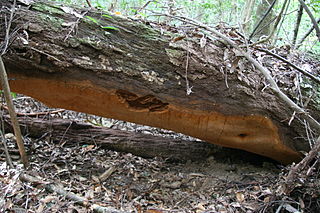
Phellinus ellipsoideus is a species of polypore fungus in the family Hymenochaetaceae, a specimen of which produced the largest fungal fruit body ever recorded. Found in China, the fruit bodies produced by the species are brown, woody basidiocarps that grow on dead wood, where the fungus feeds as a saprotroph. The basidiocarps are perennial, allowing them to grow very large under favourable circumstances. They are resupinate, measuring 30 centimetres (12 in) or more in length, though typically extending less than a centimetre from the surface of the wood. P. ellipsoideus produces distinct ellipsoidal spores, after which it is named, and unusual setae. These two features allow it to be readily differentiated microscopically from other, similar species. Chemical compounds isolated from the species include several steroidal compounds. These may have pharmacological applications, but further research is needed.

Neoantrodia serialiformis is a species of polypore fungus in the family Fomitopsidaceae. The fungus is resupinate, consisting of a fertile spore-bearing pore surface lying flat on the underside of decaying wood, although one or more fan-shaped overlapping caps may also be formed. Although quite common in the eastern United States, it was not recognized as a distinct species until 2009, owing to its resemblance to the closely related Neoantrodia serialis. Differences in ecology, spore size, and DNA sequences distinguish the two lookalikes.

Picipes badius, commonly known as the black-footed polypore or black-leg, is a species of fungus in the family Polyporaceae. It causes a white rot of hardwoods and conifers. The species is found in temperate areas of Asia, Australia, Europe, and North America. It has a dark brown or reddish-brown cap that reaches a diameter of 25 cm (9.8 in), and a stipe that is often completely black or brown at the top and black at the base.

Hapalopilus rutilans is a species of polypore fungus in the family Polyporaceae. Officially described in 1821, it was transferred to its current genus Hapalopilus six decades later. It is commonly known as the tender nesting polypore, purple dye polypore, or the cinnamon bracket. This widely distributed species is found on five continents. It grows on the fallen or standing dead wood of deciduous trees, in which it fruits singly, in groups, fused, or in overlapping clusters. Fruit bodies are in the form of kidney-shaped to semicircular, cinnamon-orange-brown brackets. The underside of the fruit body features a yellowish to brownish pore surface with tiny angular pores, from which spores are released.

Pycnoporellus alboluteus, commonly known as the orange sponge polypore, is a species of polypore fungus in the family Fomitopsidaceae. Distributed throughout the boreal conifer zone, the fungus is found in mountainous regions of western North America, and in Europe. It causes a brown cubical rot of conifer wood, especially spruce, but also fir and poplar. The soft, spongy orange fruit bodies grow spread out on the surface of fallen logs. Mature specimens have tooth-like or jagged pore edges. A snowbank mushroom, P. alboluteus can often be found growing on logs or stumps protruding through melting snow. Although the edibility of the fungus and its usage for human culinary purposes are unknown, several species of beetles use the fungus as a food source.

Boletus subluridellus is a species of bolete fungus in the family Boletaceae. Described as new to science in 1971 by American mycologists, the bolete is found in the eastern United States and Canada. It grows on the ground in coniferous and mixed forests in a mycorrhizal association with deciduous trees, especially oak. The fruit bodies (mushrooms) have orangish-red, broadly convex caps that are up to 10 cm (3.9 in) in diameter, with small, dark reddish pores on the underside. The pale yellow stipe measures 4–9 cm (1.6–3.5 in) long by 1.5–2.3 cm (0.6–0.9 in) thick. All parts of the fruit body will quickly stain blue when injured or touched.
Laetiporus ailaoshanensis is a species of polypore fungus in the family Fomitopsidaceae. It is found in southwestern China, where it grows on Lithocarpus. The species was described as new to science in 2014 by Baokai Cui and Jie Song. Its fruit body has an orange-yellow to reddish-orange cap surface, with cream to buff pores on the cap underside. The fungus produces ovoid to ellipsoid basidiospores that measure 5.0–6.2 by 4.0–5.0 μm. Molecular analysis of internal transcribed spacer DNA sequences indicate that L. ailaoshanensis is a unique lineage in the genus Laetiporus.

Laetiporus conifericola is a species of polypore fungus in the family Fomitopsidaceae. It is found in western North America ranging from California to Alaska, where it grows as a plant pathogen on conifer trees, particularly fir, spruce, and hemlock. Fruit bodies of the fungus comprise overlapping pore-bearing plates, measuring collectively up to 60 cm (24 in) across, and up to 4 cm (2 in) thick. Their color ranges from bright orange to salmon orange on the upper surface of the cap and stipe, with a yellow pore surface on the cap underside. Spores are egg-shaped, smooth, hyaline (translucent), and measure 6.5–8.0 by 4.0–5.0 μm. The species has a pleasant odour when fresh.
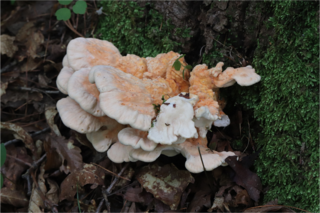
Laetiporus cremeiporus is a species of polypore fungus in the family Fomitopsidaceae. It is found in cooler temperate areas of China and Japan, where it grows on logs and stumps of hardwood trees, especially oak. The fruit body of the fungus comprises large masses of overlapping reddish-orange caps with a cream-colored pore surface on the underside.

Laetiporus gilbertsonii is a species of polypore fungus in the family Fomitopsidaceae. It is found in western North America. It was one of three new Laetiporus species published in 2001, which were distinguished genetically from the common Laetiporus sulphureus; the others were L. conifericola and L. huroniensis. The type collection, made in San Francisco's Golden Gate Park in 1997, was found fruiting on a eucalyptus tree. It has also been collected in Oregon and Washington. The fungus is named in honor of mycologist Robert Lee Gilbertson. L. gilbertsonii is edible, although some people have reported experiencing upset stomach after consuming it. Laetiporus conifericola is very similar in appearance, but is readily distinguished by its growth on conifers.
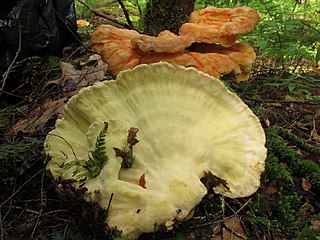
Laetiporus huroniensis is a species of polypore fungus in the family Fomitopsidaceae. It is found in the Great Lakes region of eastern North America, where it fruits on large logs in old growth conifer forests. The type collection, made in Ottawa National Forest in September 1999, was found fruiting on Tsuga canadensis. It was one of three new Laetiporus species published in 2001, which were distinguished genetically from the widespread Laetiporus sulphureus; the others were L. conifericola and L. gilbertsonii.

Bondarzewia berkeleyi, commonly known as Berkeley's polypore, or stump blossoms, is a species of polypore fungus in the family Russulaceae. It is a parasitic species that causes butt rot in oaks and other hardwood trees. A widespread fungus, it is found in Africa, Asia, Europe, and North America.

Nigroporus vinosus is a species of poroid fungus in the family Steccherinaceae, and the type species of the genus Nigroporus. Its fruit bodies have brownish caps with tinges of purple or red. The cap underside has a pore surface the same colour as the cap, and minute pores. Nigroporus vinosus has a pantropical distribution. It has been recorded from Africa, North America, Central America, South America, Asia, and Oceania. It is a wood-decay fungus that causes a white rot.
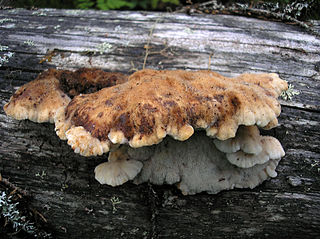
Amylocystis lapponica is a species of bracket fungus in the family Fomitopsidaceae, and the type species of genus Amylocystis. It produces medium-sized, annual fruit bodies that are soft, and have a strong, distinct smell. The fungus is a saprophyte that feeds on coniferous wood of logs lying on the ground, and causes brown rot. It is a rather rare species that only occurs in old-growth forest.



















